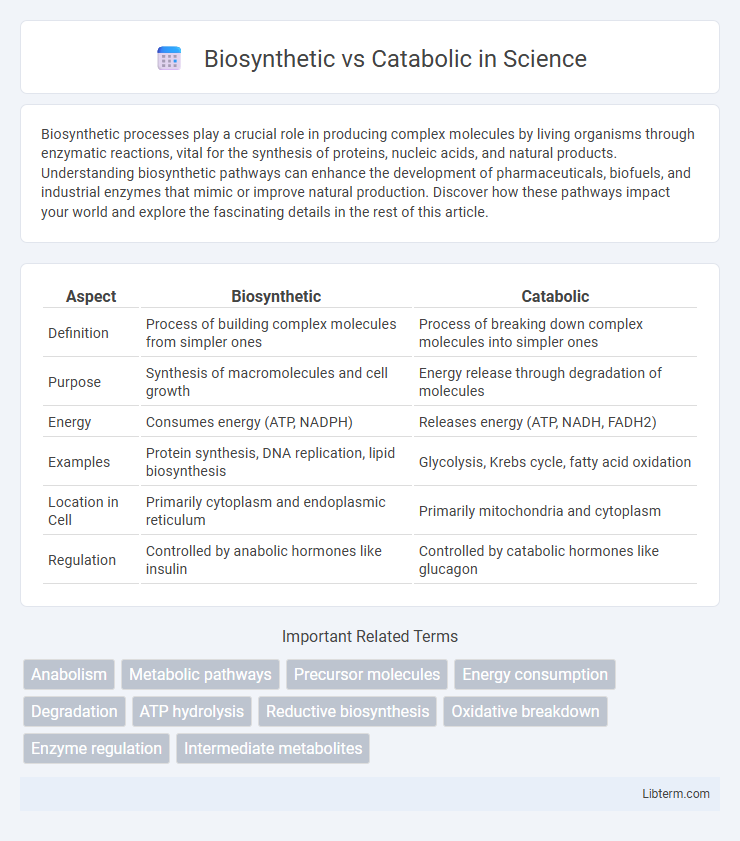Biosynthetic processes play a crucial role in producing complex molecules by living organisms through enzymatic reactions, vital for the synthesis of proteins, nucleic acids, and natural products. Understanding biosynthetic pathways can enhance the development of pharmaceuticals, biofuels, and industrial enzymes that mimic or improve natural production. Discover how these pathways impact your world and explore the fascinating details in the rest of this article.
Table of Comparison
| Aspect | Biosynthetic | Catabolic |
|---|---|---|
| Definition | Process of building complex molecules from simpler ones | Process of breaking down complex molecules into simpler ones |
| Purpose | Synthesis of macromolecules and cell growth | Energy release through degradation of molecules |
| Energy | Consumes energy (ATP, NADPH) | Releases energy (ATP, NADH, FADH2) |
| Examples | Protein synthesis, DNA replication, lipid biosynthesis | Glycolysis, Krebs cycle, fatty acid oxidation |
| Location in Cell | Primarily cytoplasm and endoplasmic reticulum | Primarily mitochondria and cytoplasm |
| Regulation | Controlled by anabolic hormones like insulin | Controlled by catabolic hormones like glucagon |
Introduction to Biosynthetic and Catabolic Pathways
Biosynthetic pathways, also known as anabolic pathways, involve the construction of complex molecules from simpler ones, essential for cell growth and repair and requiring energy input often in the form of ATP. Catabolic pathways break down complex molecules into simpler compounds, releasing energy stored in chemical bonds, primarily captured as ATP or NADH for cellular activities. These metabolic pathways work in tandem to maintain cellular energy balance and support vital functions such as biosynthesis and energy production.
Defining Biosynthesis: Building Biomolecules
Biosynthesis involves enzymatic processes that construct essential biomolecules such as proteins, nucleic acids, lipids, and carbohydrates from simpler precursors. This anabolic pathway is critical for cellular growth, repair, and function, utilizing energy-rich molecules like ATP to drive the formation of complex structures. In contrast, catabolic pathways break down these molecules to release energy, highlighting biosynthesis's role in building and maintaining biological complexity.
Understanding Catabolism: Breaking Down Compounds
Catabolism involves the metabolic pathways that break down complex molecules such as carbohydrates, lipids, and proteins into simpler units like glucose, fatty acids, and amino acids, releasing energy stored in chemical bonds. This energy is often captured in the form of adenosine triphosphate (ATP), which fuels cellular processes and maintains biological functions. Key catabolic reactions include glycolysis, the citric acid cycle, and oxidative phosphorylation, all pivotal for sustaining life by converting nutrients into usable energy.
Key Differences Between Biosynthetic and Catabolic Processes
Biosynthetic processes involve the construction of complex molecules from simpler ones, utilizing energy to build essential compounds like proteins, nucleic acids, and lipids necessary for cell growth and repair. In contrast, catabolic processes break down complex molecules into simpler units, releasing energy stored in chemical bonds, which powers cellular activities and maintains metabolic balance. The key difference lies in their metabolic roles: biosynthesis is anabolic and energy-consuming, while catabolism is degradative and energy-yielding.
Major Enzymes Involved in Biosynthesis vs Catabolism
Major enzymes involved in biosynthesis include DNA polymerase, RNA polymerase, and aminoacyl-tRNA synthetase, which facilitate the assembly of nucleic acids and proteins. In contrast, catabolism relies on enzymes such as dehydrogenases, hydrolases, and proteases that break down complex molecules into simpler ones for energy release. Key biosynthetic pathways involve enzymes like acetyl-CoA carboxylase in fatty acid synthesis, whereas catabolic processes utilize enzymes like hexokinase in glycolysis and lipase in lipid degradation.
Energy Dynamics: ATP Consumption and Generation
Biosynthetic pathways primarily consume ATP to drive the assembly of complex molecules from simpler precursors, requiring substantial energy input for anabolic reactions such as protein and nucleic acid synthesis. Catabolic pathways generate ATP by breaking down complex molecules like carbohydrates, fats, and proteins into simpler units through processes such as glycolysis, the citric acid cycle, and oxidative phosphorylation. The balance between ATP consumption in biosynthesis and ATP generation in catabolism is central to cellular energy homeostasis and metabolic regulation.
Regulation and Control of Metabolic Pathways
Biosynthetic and catabolic pathways are tightly regulated through allosteric enzymes and feedback inhibition to maintain metabolic balance. Key regulatory molecules such as ATP, AMP, and NADH signal the energy status of the cell, activating catabolic pathways during low energy states and biosynthetic pathways when energy is abundant. Enzyme phosphorylation and gene expression modulation further fine-tune these pathways, ensuring precise control of metabolite flow and resource allocation.
Examples of Biosynthetic Reactions in Living Organisms
Biosynthetic reactions in living organisms include processes like protein synthesis, where amino acids are assembled into polypeptides, and DNA replication, involving the formation of nucleotide chains. Photosynthesis is another key biosynthetic example, converting carbon dioxide and sunlight into glucose and oxygen. These anabolic pathways construct complex molecules essential for cellular function and growth, contrasting with catabolic reactions that break down molecules for energy.
Common Catabolic Pathways in Cellular Metabolism
Common catabolic pathways in cellular metabolism include glycolysis, the citric acid cycle, and oxidative phosphorylation, which collectively break down glucose and other molecules to generate ATP. These pathways involve enzymatic reactions that convert substrates into energy-rich compounds, releasing energy stored in chemical bonds. Catabolic processes are essential for maintaining cellular energy balance and providing intermediates for biosynthetic pathways.
Clinical and Biotechnological Implications of Metabolic Pathways
Biosynthetic pathways generate essential biomolecules such as nucleotides, amino acids, and lipids, making them critical for tissue repair, growth, and drug development in clinical settings. Catabolic pathways break down substrates like glucose and fatty acids to produce ATP, with implications in metabolic disorders such as diabetes and obesity, guiding therapeutic interventions. Biotechnologically, manipulating these pathways enhances production of antibiotics, biofuels, and recombinant proteins, optimizing yields and reducing costs in industrial processes.
Biosynthetic Infographic

 libterm.com
libterm.com